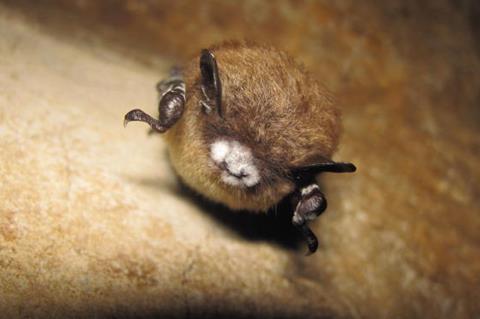The fungal pathogen that causes white-nose syndrome (WNS) in bats uses different cell entry strategies depending on the host’s hibernation status – cold and inactive, or warm and active.

The findings, which required the authors to develop a new bat cell line, highlight potential therapeutic interventions against WNS using epidermal growth factor receptor inhibitors, like the Food and Drug Administration-approved drug gefitinib.
Bats – the second-most diverse group of mammals – play an important part in mitigating agricultural pests and the spread of insect-borne disease. However, millions of hibernating bats across North America are dying from white-nose syndrome – a fatal emerging disease caused by the cold-loving fungus, Pseudogymnoascus destructans. WNS is thought to be responsible for a more than 95% decline in some species and the extirpation of entire populations in some regions.
READ MORE: Bats disturbed by humans are more frequently infected with coronaviruses
READ MORE: Novel early-detection method aims to stem disease spread in animal trade
Although WNS was discovered decades ago, there is no practical way to stop the spread of the disease among susceptible bat species, highlighting an urgent need for treatment and prevention strategies.
Invading host tissue
A lack of understanding about how P. destructans invades host tissue, particularly when bats hibernate, has hindered the development of WNS interventions. To address these unknowns, Marcos Isidoro-Ayaza and Bruce Klein developed a novel immortalized keratinocyte cell line from the little brown bat (Myotis lucifugus) and studied P. destructans invasion, in vivo, at different temperatures – to mimic hibernation and arousal.
Isidoro-Ayaza and Klein discovered that the fungus uses different strategies to invade bat epidermis cells depending on whether the bats are in their cold, inactive hibernation state or their warmer, active arousal state.
Hibernation strategies
During hibernation, when endocytic uptake is idle in the host, fungal hyphae emerging from germinating spores actively tunnel through keratinocytes. Unexpectedly, the burrowing hyphae do not provoke immune defenses in the host cells.
Conversely, when temperatures are warmer and the bats are active, the fungus is internalized by keratinocytes via endocytosis. According to the findings, both infection routes require the epidermal growth factor receptor (EGFR), and the authors show that blockade of EGFR using the small-molecule drug gefitinib and anti-EGFR antibodies prevented P. destructans entry into host keratinocytes.
“Host invasion is one of the first steps in disease establishment and critical to disease progression,” writes José Vargas-Muñiz in a related Perspective. “Therefore, this process is a prime candidate for mitigating [P. destructans] infection in hibernating bats.”
Topics
- bats
- Bruce Klein
- Ecology & Evolution
- Fungi
- gefitinib
- Healthy Land
- hibernation
- Infectious Disease
- José Vargas-Muñiz
- keratinocytes
- Marcos Isidoro-Ayaza
- Myotis lucifugus
- Pseudogymnoascus destructans
- Research News
- University of Wisconsin-Madison
- USA & Canada
- Veterinary Medicine & Zoonoses
- Virginia Tech
- white-nose syndrome







No comments yet